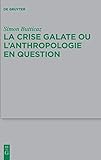La crise galate ou l’anthropologie en question / Simon Butticaz.
Material type: TextSeries: Beihefte zur Zeitschrift für die neutestamentliche Wissenschaft ; 229Publisher: Berlin ; Boston : De Gruyter, [2018]Copyright date: ©2018Description: 1 online resource (XIV, 316 p.)Content type:
TextSeries: Beihefte zur Zeitschrift für die neutestamentliche Wissenschaft ; 229Publisher: Berlin ; Boston : De Gruyter, [2018]Copyright date: ©2018Description: 1 online resource (XIV, 316 p.)Content type: - 9783110573428
- 9783110573602
- 9783110574296
- Christianity and culture -- Rome
- Group identity -- Biblical teaching
- Honor in the Bible
- Justification (Christian theology) -- Biblical teaching
- Theological anthropology -- Christianity -- Biblical teaching
- Anthropologie
- Apostel Paulus
- Ehre
- Galaterbrief
- RELIGION / Biblical Criticism & Interpretation / New Testament
- Anthropology
- Galatians
- Honor and Shame
- Paul
- 234.7 23
- BS2685.6.I33 B88 2018
- BS2655.J8 .B888 2018
- online - DeGruyter
- Issued also in print.
| Item type | Current library | Call number | URL | Status | Notes | Barcode | |
|---|---|---|---|---|---|---|---|
 eBook
eBook
|
Biblioteca "Angelicum" Pont. Univ. S.Tommaso d'Aquino Nuvola online | online - DeGruyter (Browse shelf(Opens below)) | Online access | Not for loan (Accesso limitato) | Accesso per gli utenti autorizzati / Access for authorized users | (dgr)9783110574296 |
Frontmatter -- Avant-propos -- Table des matières -- Liste des abréviations -- 1 Introduction -- 2 Le «canon» paulinien face aux Galates (1,1–12 et 6,11–18) -- 3 Paul, témoin vivant de l’Evangile (1,13–2,14) -- 4 La justification par la foi ou l’«universalisation anthropologique» du discours (2,15–21) -- 5 Abraham le croyant (3,1–14) -- 6 La fin des sources mondaines de (dis‐)qualification : magna charta de l’anthropologie paulinienne (3,26–29 -- 7 L’allégorie des deux lignées (4,21–31) -- 8 La «foi agissant par l’amour» : une anthropologie à deux dimensions (5,1–12) -- 9 L’amour réciproque versus la φιλοτιμία : l’incidence pratique de l’Evangile paulinien (5,13–6,10) -- 10 Récapitulation et conclusion -- 11 Bibliographie -- Index des sources anciennes
restricted access online access with authorization star
http://purl.org/coar/access_right/c_16ec
Outillé de l’analyse socio-rhétorique et empruntant à l’anthropologie culturelle, ce livre consacré à la crise galate entre en débat critique avec la New Perspective on Paul, un courant qui, depuis une génération maintenant, secoue les paramètres de l’interprétation paulinienne. Entérinant la recomposition socio-identitaire du contexte de communication défendue par ce cercle de savants, l’auteur reconnaît en Galates un déplacement de perspective, Paul identifiant dans l’Evangile de ses opposants un péril anthropologique affectant l’être: la culture antique de l’honneur.
This book, dedicated to the Galatian crisis, combines socio-rhetorical analysis with methods drawn from cultural anthropology. It engages in critical debate with the “New Perspective on Paul,” a scholarly trend that, for a generation now, has been altering the parameters of Pauline studies. Accepting the idea defended by this group of scholars, namely that Paul’s communicative context is one based on social identity, the author sees a change of perspective in Galatians. In the Gospel of his opponents, Paul identifies a perilous anthropological problem: the ancient culture of honor. Linked to the particular issue of a reversion to the Torah, the conflict in Galatia highlights a potentially universal theological problem: the opposition of "the Gospel of Christ" (Gal 1:7) to the anthropology of honor found throughout the ancient Mediterranean. The Epistle to the Galatians, which addresses the preaching of the so-called “advocates of circumcision,” sketches out a human identity (both in its foundation and in its morality) based on grace and removed from worldly principles. It foreshadows the universalizing message that Paul would send to the Romans. A fundamental connection between these two letters thus becomes apparent.
Issued also in print.
Mode of access: Internet via World Wide Web.
In French.
Description based on online resource; title from PDF title page (publisher's Web site, viewed 28. Feb 2023)


